
The coursers are a subfamily (Cursoriinae) of birds which together with the pratincoles make up the family Glareolidae. They have long legs, short wings and long pointed bills which curve downwards. Their most unusual feature for birds classed as waders is that they inhabit deserts and similar arid regions.

The greater yellowlegs is a large shorebird in the family Scolopacidae. It breeds in central Canada and southern Alaska and winters in southern North America, Central America, the West Indies and South America.
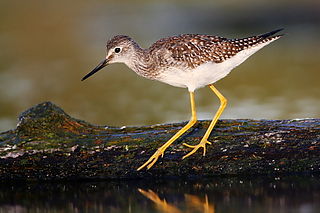
The lesser yellowlegs is a medium-sized shorebird. It breeds in the boreal forest region of North America.

The short-billed dowitcher, like its congener the long-billed dowitcher, is a medium-sized, stocky, long-billed shorebird in the family Scolopacidae.

The cream-colored courser is a wader in the pratincole and courser family, Glareolidae. Both parts of the scientific name derive from Latin cursor, "runner", from currere, "to run" which describes their usual habit as they hunt their insect prey on the ground in dry open semi-desert regions of the Middle East and northern Africa.

The yellow bittern is a small bittern. It is of Old World origins, breeding in the northern Indian Subcontinent, east to the Russian Far East, Japan and Indonesia. It is mainly resident, but some northern birds migrate short distances. It has been recorded as a vagrant in Alaska and there is a single sighting in Great Britain, from Radipole Lake, Dorset on November 23, 1962 – however, the British Ornithologists' Union has always considered this occurrence to be of uncertain provenance and currently it is not accepted onto the official British List.

The western plantain-eater, also known as the gray plantain-eater or western gray plantain-eater, is a large member of the turaco family, a group of large arboreal near-passerine birds restricted to Africa.

Gallinago is a genus of birds in the wader family Scolopacidae, containing 18 species.
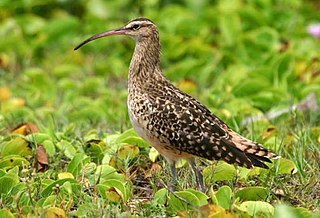
The bristle-thighed curlew is a medium-sized shorebird that breeds in Alaska and winters on tropical Pacific islands.
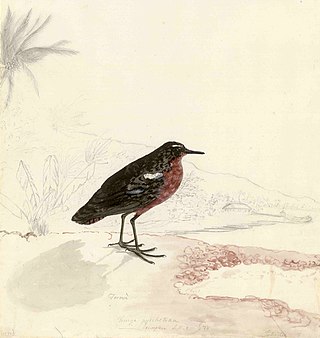
The Tahiti Sandpiper or Tahitian Sandpiper is an extinct member of the large wader family Scolopacidae that was endemic to Tahiti in French Polynesia until its extinction sometime before 1819.
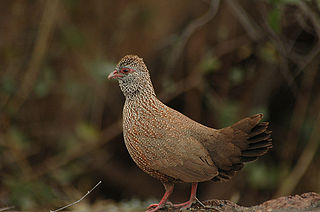
The stone partridge is a bird of the New World quail family. This largely brown bird, which commonly holds its tail raised, is found in scrubland and lightly wooded habitats, often near rocks, from Kenya and Ethiopia to Gambia.
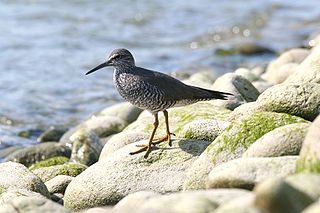
The wandering tattler, is a medium-sized wading bird. It is similar in appearance to the closely related gray-tailed tattler, T. brevipes. The tattlers are unique among the species of Tringa for having unpatterned, greyish wings and backs, and a scaly breast pattern extending more or less onto the belly in breeding plumage, in which both also have a rather prominent supercilium.
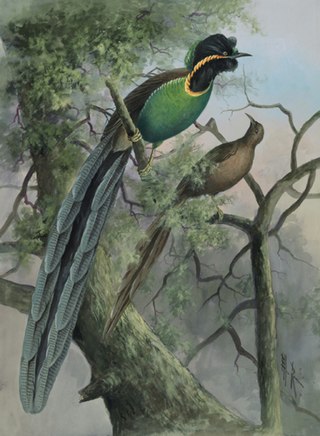
The Arfak astrapia is a species of astrapia, a group of birds found in the birds-of-paradise family Paradiseidae.

The Indian courser is a species of courser found in mainland South Asia, mainly in the plains bounded by the Ganges and Indus river system. Like other coursers, it is a ground bird that can be found in small groups as they forage for insects in dry open semi-desert country.
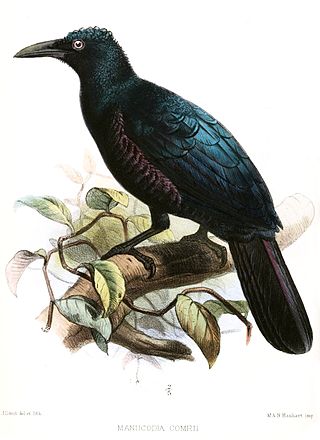
Manucodes are birds-of-paradise in the genus Manucodia, that are medium-sized with black-glossed purple and green plumages.
The Phoenix petrel is a medium-sized tropical seabird, measuring up to 35 cm (1.15 ft) long, with a wingspan of 83 cm (2.72 ft). It has a dark brown upperparts plumage, white below and whitish throat. The sexes are similar.

Temminck's courser is a bird in the pratincole and courser family, Glareolidae. It is a wader which lives in sub-Saharan Africa. It is noted for laying its dark ash-black eggs in the burnt bushes and grass of the African savannah.
The Polynesian storm petrel is a species of seabird in the family Oceanitidae. It is the only species placed in the genus Nesofregetta.
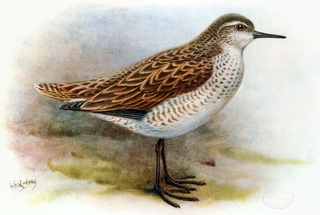
The Christmas sandpiper or Kiritimati sandpiper was a small shorebird. It became extinct some time in the first half of the 19th century. It was endemic to Christmas Island, since 1919 part of Kiribati. It is known solely from a single contemporaneous illustration, and a description by William Anderson, both made during the third circumnavigation voyage commanded by Captain James Cook, which visited the atoll of Christmas Island between 24 December 1777 and 2 January 1778.
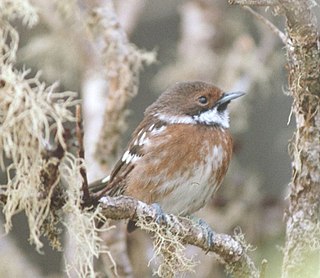
The Hawaiʻi ʻelepaio, also Hawaiian ʻelepaio, is a monarch flycatcher found on the Big Island of Hawaii. Until 2010, all three ʻelepaio species, the Kauaʻi ʻelepaio, the Oʻahu ʻelepaio and this species were considered conspecific.




















